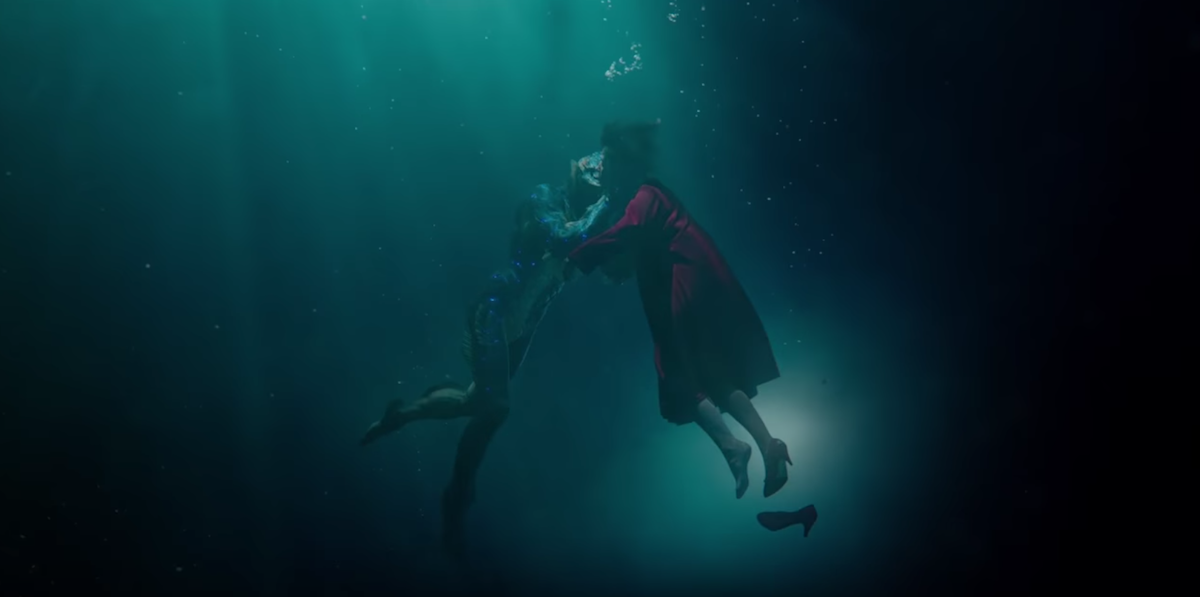This piece contains spoilers for Guillermo Del Toro’s The Shape of Water. If you haven’t seen the film yet, consider swimming away now.
Guillermo Del Toro’s latest film, The Shape of Water was very much what I expected it to be going in — full of fantasy and a fondness for the strange, but grounded in real emotions. Water isn’t a perfect film, and it can come across as a bit heavy-handed at times, but the ideas of romance and beauty presented here are a welcome subversion to what we are usually given in popular narratives. The film’s subversive approach to love, desire, and acceptance give this escapist fantasy a very real and visceral heart.
In the film, Elisa Esposito (played with charm by Sally Hawkins) is a mute janitor who works the night shift at a government facility. Her life is pretty routine, but everything changes when a new asset comes into the building — a fish man from South America. At first, their meetings are brief and limited, but Elisa is fascinated, and a lovely friendship blossoms between the two. She teaches him how to communicate using sign language, shares jazz records, and brings him hard-boiled eggs for lunch. However, the horrifying plans being laid out for the creature by government operatives pose a real threat to the pair. As their friendship turns into something more, Elisa decides that she needs to help him escape.
It’s a tale as old as time (not sorry). A beauty meets a beast, and ultimately there is a transformation. More often than not, this means that the “beauty” (often a woman) is tasked with pouring an excessive amount of emotional labor into helping her beast (often a man) go from shitty monster to semi-decent human being. Sometimes this trope is gender-flipped, or even ends in a non-physical transformation, but Water changes things up in an even more surprising way. Instead of our heroine, Elisa, wasting her patience and kindness on the bad attitude/emotional immaturity of the beast, del Toro offers a dazzling alternative: a kind and curious companion.
Elisa realizes that the creature is emotionally intelligent and capable of understanding her signing. Unlike the majority of beauty and the beast stories, she is not coerced into teaching him. Instead, this learning experience is a genuine moment of growth between the two, and it’s refreshing to watch. Elisa is able to see the best things the creature is capable of, and she coaxes those things out of him. There’s still work put into the relationship, but it’s coming from both parties.
This is a powerful change, because usually the Beauty and the Beast story can be seen as a way to excuse monstrous men by placing the burden of transforming them onto the women in their lives. Here, it’s not a one-sided transformation, but a unified growth. Through her work with the creature, Elisa finds a new and unique companionship. In fact, it is she who is transformed in the end, but not in the way we’ve been taught to expect. Instead of finally being able to speak and become “normal” by society’s standards, the scars across her neck, remnants of the incident that muted her, become gills allowing her to be with the creature forever and leave an ableist society far behind.
While the subversion of the classic Beauty and the Beast tale is an impactful element, there are a few other things that set Water apart.
The film’s frank portrayal of female desire and sexuality is important to acknowledge within the context of our present day reality. More often than not in films, women do not hold agency over their own sexuality. They’re objects of the male gaze — passive and compliant. As Laura Mulvey put it in her seminal essay, Visual Pleasure and Narrative Cinema, “The determining male figure projects its phantasy onto the female figure which is styled accordingly.” While del Toro works against this trope, he also provides an example of it in the gross actions of Michael Shannon’s government villain, who constantly belittles and harasses Elisa. This is especially effective because he provides a contrast to this behavior in the behavior of the creature.
Throughout Water, del Toro gives Elisa agency over her desires and respects them. A scene early in the film where she masturbates in a tub is shot from a distance and implied to be a part of her routine, acknowledging this in a frank way. Also, yes, for everyone wondering, there is fishman sex but it’s not treated as sensationally as it might sound, mainly because del Toro again respects his characters’ actions. Their sex isn’t played for spectacle or voyeurism but placed as a natural next step in the characters’ relationship. Elisa has complete agency over her sexuality, and is even the one who initiates things. Thanks to this important action, her desires are acknowledged and understood, making for a much more believable and tender depiction of romance within the film.
Guillermo del Toro’s fondness for the unusual and macabre should come as no surprise to anyone familiar with his work, but here it is the most pronounced. This movie is, after all, a love story between a human woman and a fishman; but it’s also a love letter to people whom society marginalizes and alienates. Elisa’s friends make up the supporting characters of the film, and they are: Giles, a closeted gay man; and Zelda, a black woman.
It’s admirable that in a year when xenophobia and bigotry have centered themselves at the highest levels of power in this country, Water makes marginalized people heroes. A story like this is not only timely, but necessary.
If you would have told me all of this a few years ago, I probably wouldn’t have thought much of this film beyond an admiration for del Toro’s unique stories. While that admiration is solidly present, The Shape of Water is a fitting love story for our times because of so much more. Its subversion of ideas society holds about romance, how female desires are depicted on screen, and who gets to be the heroes of a movie, are a necessary salve in today’s unwelcoming world.
Given the state of things, it’s sometimes tough for me to remember that there are beautiful things happening alongside the horrific. Del Toro’s latest film is a firm reminder that “love is real—absolutely real, and like water, it is the most gentle and most powerful force in the universe.” Is there anything more romantic than that?







